When I arrive at her gallery in Venice, Calif., I'm not quite sure which Genevieve Gaignard I'll be meeting. The photographer and installation artist has made her name by role-playing, inhabiting various campy, hyperbolic guises: a slightly meek and obsessively organized feline fanatic; a blinged-out disco diva with a teased Afro; a voluptuous California babe. (Before you ask--yes, she's sick of being compared to Cindy Sherman, the inevitable curse of any young artist exploring self-portraiture with a knack for dress-up.) Gaignard has built entire self-contained tableaux around these photographic character studies: a knick-knack-cluttered living room for her cat lady, or a baby-blue-and-pink-accented bathroom for a beehived beauty who nods her hip to John Waters's Hairspray. The Gaignard who greets me at Shulamit Nazarian gallery is sporting a funky, red pair of eyeglasses, but is reserved by comparison. I've just spent half an hour walking around Muscle Beach, a surreal playground of make-believe. So it feels appropriate to spend the morning here, talking about how identity is just another metaphorical pair of clothes, depending on the day, and one's mood.
Gaignard grew up in a rural Massachusetts town. Her mother is white, and her father is black, and that mixed background is the crux of the work she makes. If Sherman's cinematic self-portraiture is partly about exploring the many ways there are to be a woman, Gaignard is interested in a different type of fluidity and indeterminate identity. She's constantly navigating the branches of her family tree, and the way that race is alluded to through mass culture and consumer goods.
"When I make an installation," she says, "I want it to be somewhere between a Wes Anderson film and Harmony Korine's Gummo: gross and perfect at the same time." Gaignard pauses for a beat. "But those are also super white references--so, that's always my challenge."
The artist has a refreshingly unpretentious giddiness when discussing her influences and working methods (part of her brainstorming process involves making something akin to a mood board). She came to fine art in a roundabout way. After high school she thought she'd be a baker, and enrolled at Johnson and Wales University in Rhode Island, but pastries never felt like a true calling. One of her teachers became an unofficial mentor--he had studied design at Rhode Island School of Design--and began giving Gaignard informal art assignments, like making work based on a favorite song. That sideline homework tapped into an impulse that Gaignard had exercised since high school, when she spent hours covering her walls with images clipped from magazines, turning her bedroom into one large collage--much to the chagrin of her mother, an aficionado of vintage wallpaper. "I went through this phase where Abercrombie & Fitch was really cool," she recalls. "I would rip pages out of the catalog and collage my whole wall with naked guys."
Gaignard returned to Massachusetts, where she enrolled in black-and-white photography classes at a community college and encountered the pivotal work of Diane Arbus, the famous chronicler of America's warts-and-all humanity.
"Back then," she says, "I viewed myself as someone Arbus would have photographed." After being accepted at Massachusetts College of Art and Design, she spent much of her time commuting back and forth from school to her hometown, where she was now making portraits of her own family and her neighbors.
"I would approach older women--I felt like I could, even if I didn't know them--and ask if I could photograph them in their homes," she says. "A lot of them weren't weird, but I would get them to do weird things. I remember asking my friend's grandma to stick her head in the freezer."
During a week of class assignments dealing with flesh, Gaignard took some shots of her mother in her underwear--maybe not as subversive as Leigh Ledare (Google him, just not at work), but still new and slightly uncomfortable territory. "My mom is the most willing and flexible member of my family," Gaignard says. "She'll pretty much do anything--and then regret it."
After graduating from MassArt, she once again returned close to home, taking a job at the country store in the "stop sign, pub, and post office" sparseness of Wendell, Mass. She met more of the locals, including Gay, an older woman and New York City transplant who quickly became an invaluable sounding board and supporter. She applied to Yale, and was wait-listed. The resulting frustration led to a "fuck photography" moment; Gaignard turned to video, creating offbeat films in which she and fellow Wendellians lip-synched to pop songs. In one piece, made after tabloid revelations of Chris Brown and Rihanna's domestic abuse saga, she played both sides of a duet between the celebrity-musicians. Her own race became something to tease out through art. She reflected on the uniqueness of her upbringing in a house with a "white woman who surrounded us with black Americana--these mammy salt-and-pepper shakers--and a bookshelf with 10 copies of Roots and books on Harriet Tubman."

Gaignard applied to Yale again. The second time was the charm, but she found the program to be constricting at times; in pushing back against endless and superficial comparisons to Sherman, Gaignard experimented with collage and video. She took part in a group show titled "13 Artists," featuring work from artists of color enrolled in the graduate department. Partly in response to Beyonce's "Pretty Hurts"--"really, does it? It doesn't look like it hurts at all," Gaignard snarks -- she began making faux beauty-pageant trophies, the traditional, lithe gold figurines atop them replaced by miniature replicas of the artist's own, more Rubenesque frame, 3-D scanned and printed. The trophy's tiered platforms were stocked with loaded consumer goods--a bar of skin-bleaching soap, for instance.
She also began making elaborate, often comic shoe-sculptures, like High Yellow Forest, a pair of cowboy boots festooned with dozens of tree-shaped air fresheners. (The title refers to a slang term for the skin tone of mixed-race women.) Gaignard ornamented another pair of shoes with unused tampons, a plastic spider, and the word BITCH in lurid red sparkles. That piece was born from an infuriating anecdote told by one of her male professors: He'd come across Diane Arbus in Central Park one day, looking wayward and despondent--because, tragically, she was having her period.
Gaignard's Yale MFA class's thesis show traveled to Los Angeles, where she received enough attention to spur a move to the city a little more than a year ago. There, she presented an installation exploring various California stereotypes in "A Golden State of Mind," hosted at the Cabin LA, an unconventional space sited in a cozy shack modeled on the Unabomber's forest hideaway. Late last year, at Shulamit Nazarian, in Venice, Gaignard unveiled a solo show, "Us Only," starring several distinct characters, each with her own domestic installation dotted with what the artist sometimes calls clues: a photograph of Malcolm X here, a pair of vintage mustard-yellow pumps there. Gaignard's mother--an inveterate collector of stuff--has become a creative partner, helping her locate some of her work's harder-to-find kitsch elements, like the quirky statuettes and puff-painted sweatshirts, which, in ironically hip Los Angeles, can be unexpectedly expensive.
Stylistically, Gaignard's ever-maturing work now connects to a wider field of like-minded peers: the '90s self-portraiture of Nikki S. Lee, the wide-eyed Hollywood sheen of Alex Prager, the banal-surreal vibe of Todd Solondz. But personal identity--how it is presented, and perhaps misconstrued--is still driving the artist as she tries "to bring the two worlds together-- this black-white issue." She catches herself, laughing. "Well, it's not an issue--it's just life."
 At the time of our meeting in late January, Gaignard is looking ahead to a solo presentation at Spring/Break, an offbeat, curator-driven art fair held in New York at the same time as the Armory Show. She's excited about the room she'll be showing in, which already sports evocative, 1970s-style wood paneling on two walls. The installation she has in mind will likely involve the "hair hopper" and cat lady becoming roommates; the latter has shed her shyness, and poses in a bright floral printed swimsuit on Venice Beach. Her characters continue to come of age; like Gaignard, they're still working some shit out. And in an ongoing series of mixed-media, collage-style works, the artist is making herself even more vulnerable, without hiding behind a pose or performance. The photographs here are selfies, pulled from sexts.
At the time of our meeting in late January, Gaignard is looking ahead to a solo presentation at Spring/Break, an offbeat, curator-driven art fair held in New York at the same time as the Armory Show. She's excited about the room she'll be showing in, which already sports evocative, 1970s-style wood paneling on two walls. The installation she has in mind will likely involve the "hair hopper" and cat lady becoming roommates; the latter has shed her shyness, and poses in a bright floral printed swimsuit on Venice Beach. Her characters continue to come of age; like Gaignard, they're still working some shit out. And in an ongoing series of mixed-media, collage-style works, the artist is making herself even more vulnerable, without hiding behind a pose or performance. The photographs here are selfies, pulled from sexts.
"They're things I've sent out and regret--so it's about, how can I reclaim this and put it out in a way I feel good about?" Gaignard explains. "How can I build a story out of that?"
Like what you see here? Subscribe and be the first to receive the latest issue of OUT. Subscribe to print here and receive a complimentary digital subscription.
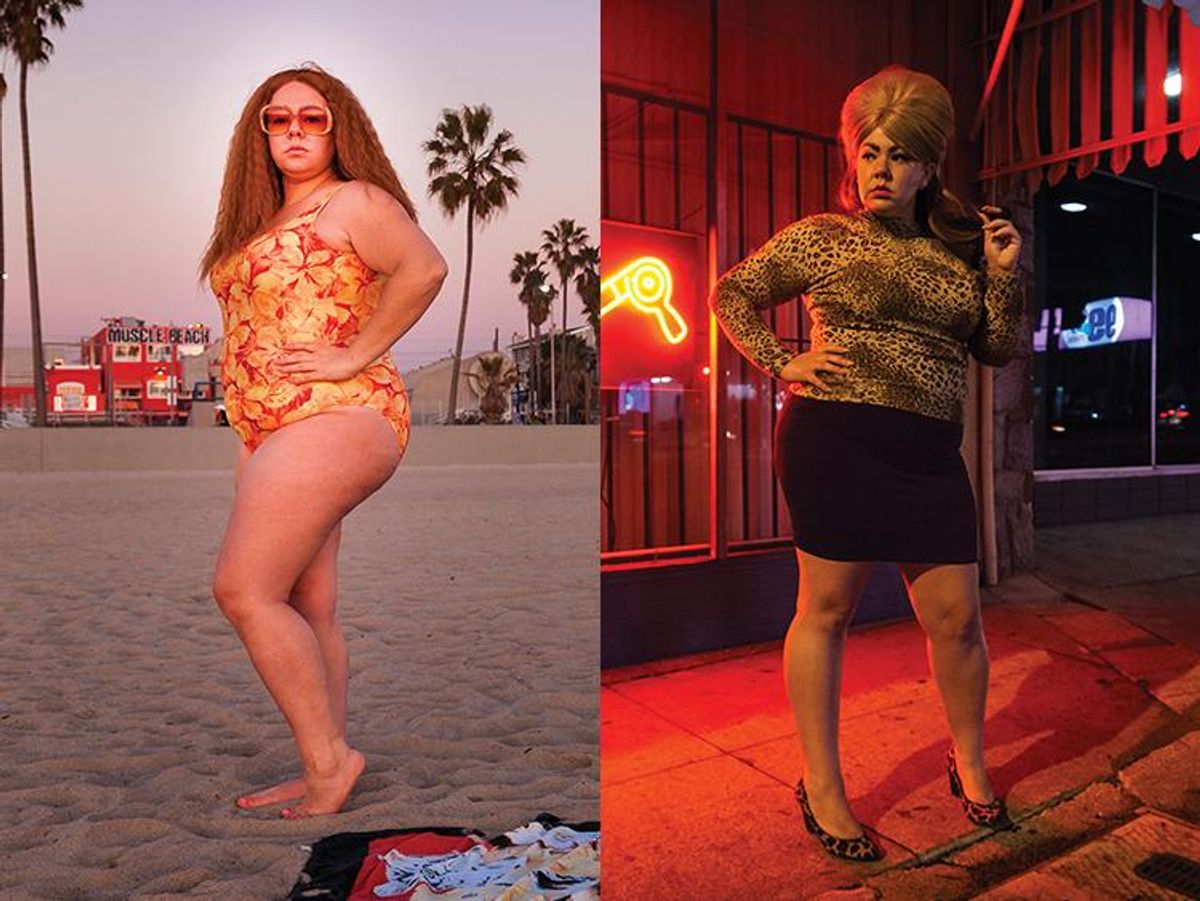



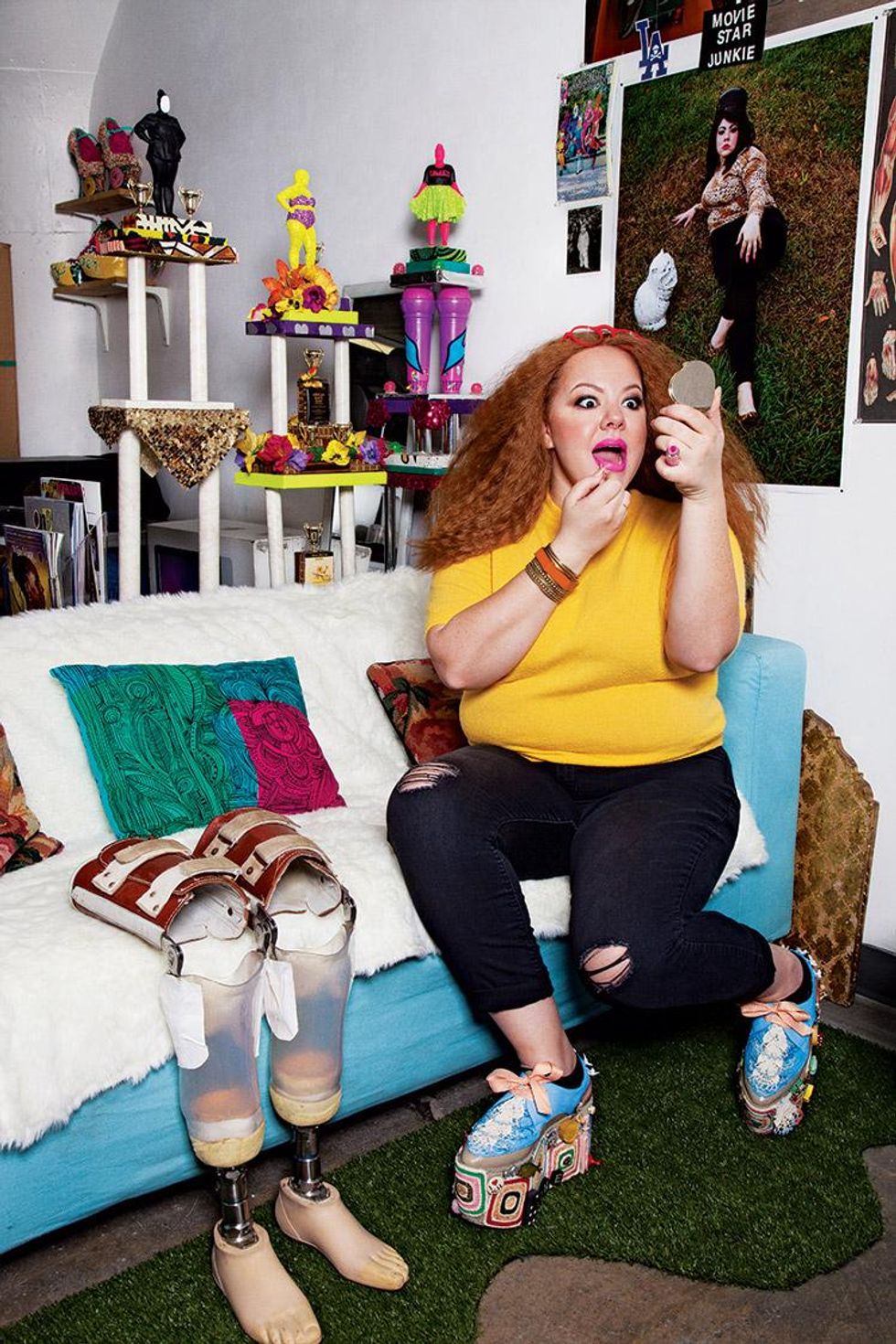
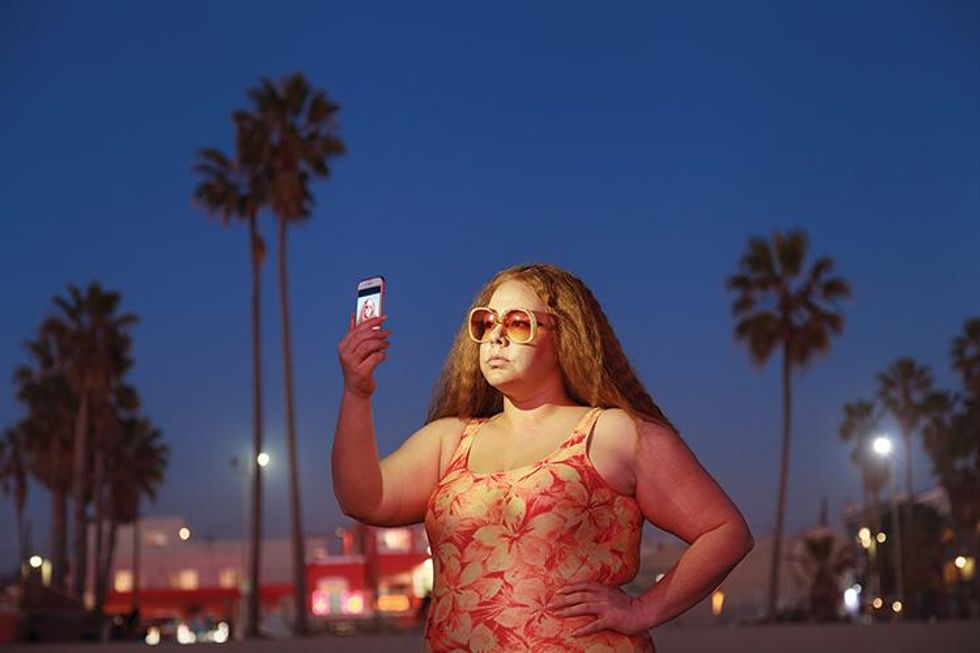 At the time of our meeting in late January, Gaignard is looking ahead to a solo presentation at Spring/Break, an offbeat, curator-driven art fair held in New York at the same time as the Armory Show. She's excited about the room she'll be showing in, which already sports evocative, 1970s-style wood paneling on two walls. The installation she has in mind will likely involve the "hair hopper" and cat lady becoming roommates; the latter has shed her shyness, and poses in a bright floral printed swimsuit on Venice Beach. Her characters continue to come of age; like Gaignard, they're still working some shit out. And in an ongoing series of mixed-media, collage-style works, the artist is making herself even more vulnerable, without hiding behind a pose or performance. The photographs here are selfies, pulled from sexts.
At the time of our meeting in late January, Gaignard is looking ahead to a solo presentation at Spring/Break, an offbeat, curator-driven art fair held in New York at the same time as the Armory Show. She's excited about the room she'll be showing in, which already sports evocative, 1970s-style wood paneling on two walls. The installation she has in mind will likely involve the "hair hopper" and cat lady becoming roommates; the latter has shed her shyness, and poses in a bright floral printed swimsuit on Venice Beach. Her characters continue to come of age; like Gaignard, they're still working some shit out. And in an ongoing series of mixed-media, collage-style works, the artist is making herself even more vulnerable, without hiding behind a pose or performance. The photographs here are selfies, pulled from sexts. 






























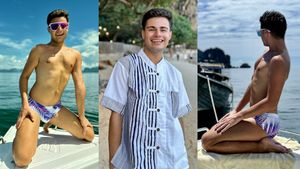









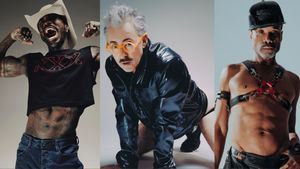






































Beware of the Straightors: 'The Traitors' bros vs. the women and gays